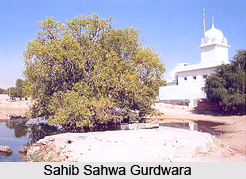 Sahib Sahwa Gurdwara, situated at Sahva village in Churu district of Rajasthan, is a highly popular and revered pilgrimage site for Sikhs. Sikh chronicles mention the place as Suheva and it is also famed as Suhava Sahib. It is said that in the year 1706 Guru Gobind Singh took refuge in this village while travelling from Punjab to the South from Nohar via Surpur. He reached the place along the old cart road which can still be found here. He stayed in the village for a while and set up his camp near the eastern bank of a pond.
Sahib Sahwa Gurdwara, situated at Sahva village in Churu district of Rajasthan, is a highly popular and revered pilgrimage site for Sikhs. Sikh chronicles mention the place as Suheva and it is also famed as Suhava Sahib. It is said that in the year 1706 Guru Gobind Singh took refuge in this village while travelling from Punjab to the South from Nohar via Surpur. He reached the place along the old cart road which can still be found here. He stayed in the village for a while and set up his camp near the eastern bank of a pond.
At each step of Guru Gobind Singh`s journey, sons of Bhai Rup Chand namely Param Singh and Dharam Singh used to make his bed. However, in the village of Sahva they could not find a suitable cot and hence improvised a bedstead with the help of wild grass and tree branches. For their service and dedication, Guru Gobind Singh bestowed his blessings on them. Near his camp, an old Jand tree stood through which a Peepul tree had sprouted. It was Guru`s prediction that since the Peepul tree grew successfully through the thorny and rough Jand tree, it was an indication that the `Khalsa` would prosper in future. Presently, in this place, only the Peepul tree stands.
On the sanctified place where Guru Gobind Singh had stayed, a memorial platform was build and was taken care of by Daulat Ram, a local devotee, and his descendants till 1873. Afterwards, a Punjabi Sikh named Ram Singh settled here as a permanent `granthi` and established a Gurdwara. In 1882, Maharaja Rajinder Singh of Patiala also made a grant of 150 mounds of wheat every year till 1951 which was converted into an annual cash grant. Bhai Ram Singh with this money initiated the construction of the present building in the year 1885 on Baisakhi day. He and his nephew served the Gurdwara as `Mahants` and the tradition was continued by their descendents. Later in 1966 Baba Baghel Singh Sevawale of Sirsa, a karsevavale activist acquired the Gurdwara from Mahant Harnam Singh. He made further developments in it and made it separate from the residential part of the house of former Mahant. He also received a land of two acres in the northern part of Gurdwara. Since then this land has been developed and enclosed into a `serai` with `Guru ka Langar`. His successor Baba Pritam Singh carried on further developments. The major festival celebrated in the Gurdwara is the birth anniversary of Guru Nanak which invites devotees from different places.





















